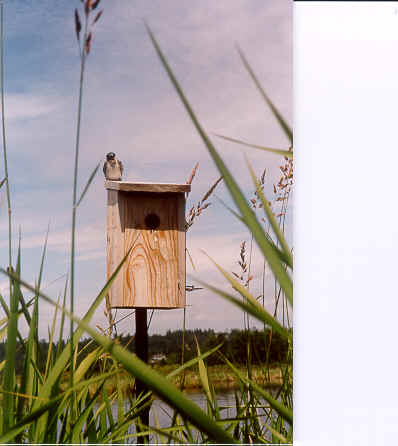(Tacycineta bicolor)

Over the past few years, Tree swallows have
been increasingly studied in contaminated habitats as possible ãbioindicatorsä
of local exposure and contaminant effects. Research* shows that
Tree swallows are exposed through their insect diet to a wide variety of
compounds, which can accumulate in their tissues, eggs and offspring. These
compounds include persistent organochlorines (e.g. PCBs, DDT, dioxins),
pesticides and heavy metals. Exposure to such substances may be associated
with altered immune function, reproductive physiology and behavior.
Erinn Birmingham is currently studying Tree swallows for her Masters project, investigating immune and reproductive endpoints in Tree swallows exposed to a variety of endocrine-disrupting compounds (chemicals that interfere with normal hormonal communication). These compounds include 4-Nonylphenol, a common pollutant in industrial and municipal wastewater that is mildly estrogenic (and possibly androgenic). My field work supplements my laboratory research, which involves dosing Zebra finches (Taeniopygia guttata) with 4-Nonylphenol and measuring similar reproductive and immune endpoints. My ultimate objective is to determine the utility of these biomarkers for studying songbird health in contaminated environments.
*References:
Auk 2000, 117(4): 987-995
Auk 1999, 116(1): 55-63
Environ. Pollution 2000, 110(2): 307-320
Environ. Toxicol. Chem. 1999, 18(11): 2519-2525
Environ. Toxicol. Chem. 1999, 18(2): 263-271
